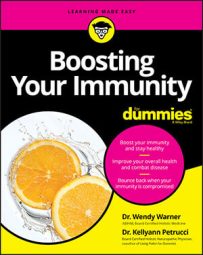The key to immune-building meals is to eat the foods that give you the nutrients you need without too many calories or blood sugar swings. You have to get enough food to feel satisfied in between meals and not feel deprived. Eating the right foods in the right amount will normalize your weight and give you more energy. You’ll get sick much less (if at all), and you’ll fight aging.
When deciding what and how much to eat, erase the idea of calories in, calories out. The concept that a calorie is a calorie is a calorie is dead. What’s more important than the calorie is the source of the calorie.
You can eat 200 calories that provide you with a nice, nutritious steady stream of fuel, or you can eat 200 calories that cause insulin to be released and are void of nutrients, which in the end won’t provide you with anything nutritional or sustaining — just calories. See the difference?
The most fattening foods at your local store aren’t the ones highest in calories but the foods that cause your blood sugar to do somersaults. The key here is quality foods. Keep your foods simple and real.
Instead of worrying about calories, think about you how much food you should have, what foods go beyond the macronutrients that boost your immunity and give you some flexibility in your meals, and how to fight sugar cravings (also known as the sugar monkey).
Just by eyeballing your food, you can determine how much is the right portion size. Meeting your daily needs, however, depends on three personal factors, which you have to gauge daily: how hungry you are, how much energy you have, and what your activity level is for that day. Your personal gauge determines how many meals or snacks to have that day.
Check out the immune-boosting plate shown and notice that the meal is based around protein. You fill the rest of your plate with a minimum of two vegetables — raw, steamed, baked, sautéed, boiled, roasted, or grilled — and one or two servings of fat (notice the avocado and olive oil).
If you built three meals a day that looked like this (with variety, of course), you’d say goodbye to illness and fat and fight aging big time!
![[Credit: Illustration by Elizabeth Kurtzman]](https://www.dummies.com/wp-content/uploads/356825.image0.jpg)
So many people blame poor soil quality for nutrient deficiency and malnutrition problems. Although poor soil quality is certainly part of the problem, the bigger problem is that people just simply don’t eat enough (if any) vegetables. Adding two vegetables per meal may seem daunting at first, but it really does get easier as you develop new habits.
Pick two days a week to prepare some of your proteins, veggies, and fruit for that week. This preparation, called batch cooking, keeps you from being unprepared — and hungry. Not having food available is a recipe for disaster.
Here are some simple guidelines for appropriate portion sizes:
Protein:
Meat or fish should be about the size and thickness of your palm. That’s 3 to 4 ounces for women and 5 to 6 ounces for men.
For organic, gluten- and sulfite-free deli meats, fold the slices over, and the serving size should measure up to the thickness of your palm.
A serving of eggs is as many as you can hold in your hand. That’s usually about three for women, four for men. If you choose to eat egg whites, just double the amount of whole eggs.
![[Credit: Illustration by Elizabeth Kurtzman]](https://www.dummies.com/wp-content/uploads/356826.image1.jpg) Credit: Illustration by Elizabeth Kurtzman
Credit: Illustration by Elizabeth Kurtzman
Vegetables: You can’t have too many vegetables on your plate! Pick two per meal, and fill your plate up, leaving room for the protein in the center.
Fruit: Eat small amounts of fruits and only between meals. A serving size is half an individual piece or a closed handful of berries.
Healthy fats:
For oils and nut butters, a serving is 1 to 2 thumb-size portions.
Half of an avocado is an easy serving size.
For coconut flakes or olives, an open handful is a serving.
Measure one closed handful of nuts or seeds for a serving.
One-third to one-half a 13.5-ounce can of coconut milk is an appropriate serving size.
![[Credit: Illustration by Elizabeth Kurtzman]](https://www.dummies.com/wp-content/uploads/356827.image2.jpg) Credit: Illustration by Elizabeth Kurtzman
Credit: Illustration by Elizabeth Kurtzman
Snacks: Snacks typically are about half the size of a regular meal — or half the plate shown. When you snack, always be sure you include a protein and a fat.
How much you eat depends on how hungry you are, your energy level, or your activity for the day. Some people do great on three meals a day; others need more. If you feel a little weak from working out or if you’re just one of those people who need more than three meals a day, adding some healthy snacks can help.

